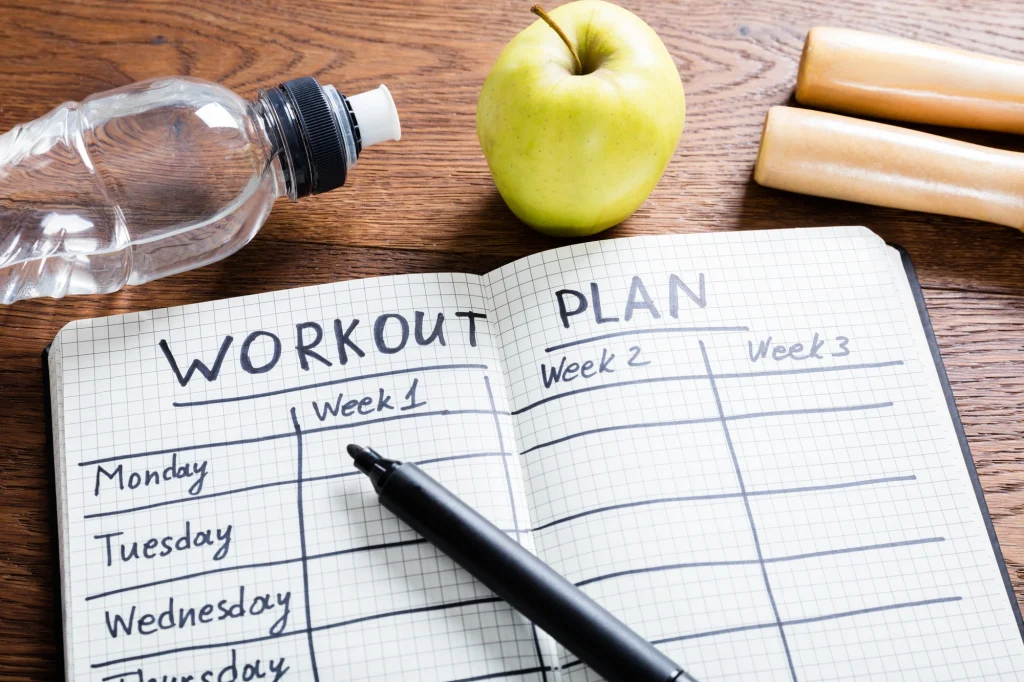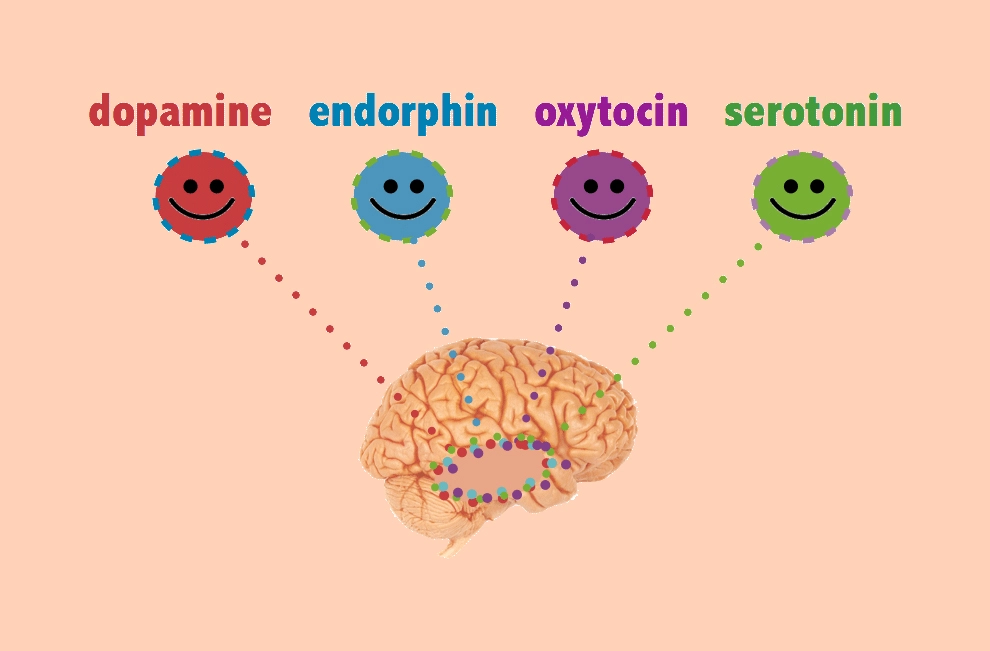Did you know that, according to the CDC, only 23% of adults meet the Physical Activity Guidelines for both strength training and aerobic activity? That shouldn’t be a big surprise as over 40% of adults in the U.S. are considered obese! Just crazy numbers.
So what to do? Well, exercise is an excellent way of controlling your weight while combating a myriad of health conditions and improving your mood.

But you may be leery of creating a workout routine, or simply not know where to begin. Do you start with cardio? Or should weights come first?
This cardio and weightlifting – aka weight training – guide walks you through the basics of setting fitness goals. You’ll learn about the best types of workouts for your personal needs, how to (potentially) lose weight, along with a detailed guide to help jumpstart your fitness journey.
So if you’re ready to get in shape and create your own workout plan keep reading!
Benefits of Exercising
Before you create your exercise plan, it’s important to understand the benefits of setting fitness goals. Once you identify the reasons why you need to implement a diet and exercise routine, you’ll be better equipped with creating and sticking to a routine that works best for you.
Weight Control

Whether you’re genetically predisposed to weight gain or simply need to lose a few pounds for health reasons, there’s no better reason to exercise than weight management. You can even keep a food journal to track calories throughout the day.
Overall Health
Exercising can help control certain health issues, mentally and physically. Exercise has been shown to reduce feelings of depression and anxiety. It can also improve your cardiovascular function, decreasing your resting heart rate and blood pressure.
According to the CDC 1 of whom I’m not a fan:
Obesity is serious because it is associated with poorer mental health outcomes and reduced quality of life. In the United States and worldwide, obesity is also associated with the leading causes of death, including deaths from diabetes, heart disease, stroke, and some types of cancer.
– Centers of Disease Control
Any steps to improve your heath is a step in the right direction. Remember, you don’t have to great to get started but you have to get started to be great!
Improves Mood and Energy

Strength training and aerobic exercise is known to produce endorphins, or “feel good” chemicals that help your mood. It also delivers oxygen and nutrients to your body’s tissues, helping your cardiovascular system perform at peak levels and increasing energy.
Creating a Workout Routine
Now that you’ve identified some key benefits of working out, you can create a workout routine based on those needs. Be sure to create reasonable goals, because, as a beginner, you run the risk of muscle strain or pushing yourself too hard, too fast.
It’s best to begin with a fitness assessment. This helps you determine your present fitness level, providing you with benchmarks to refer back to at a later date and time to track your progress.

You should invest in a fitness journal to track your progress. Begin by recording the following:
- Pulse rate before and immediately following a one-mile walk
- Duration of time to walk a mile
- Duration of time to run 1.5 miles (if comfortable for you)
- Number of pushups you can do at one time
- Number of sit-ups you can do at one time
- How close you come to reaching your toes when seated on the floor
- Waist circumference (above the hipbones)
- Body Mass Index (BMI)
- Weight
You’re probably wondering how to calculate your BMI and why this is important. Your BMI measures your body fat in comparison to your height and weight. A BMI over 25 is considered overweight, and a BMI under 18.5 is considered underweight.
One note on BMI – think of it as a guideline, not an absolute. It doesn’t differentiate between muscle mass and, well, fat. So a very healthy individual with a lot of lean muscle mass may appear to be “overweight” on the BMI scale but not even close to that in real life.
Anyways, you can calculate BMI using pounds and inches. Multiply your weight in pounds by 703. Then divide that number by your height in inches times your height in inches.
So for a 150-pound man who’s 5’8″ tall, his BMI would be calculated as such:
150×703/68²
This man has a BMI of 22.8, which is perfectly average.
Once you create your fitness baseline, you can begin personalizing your goals.
Personalize Your Fitness Goals

Now that you’ve established your current fitness level, the fun begins. Ask yourself why you’re looking to get into shape.
Is it for weight loss or to combat a health issue? Are you looking to tone up and improve your confidence? Do you just want to LGN? 2 look good nekkid. Or are you looking to compete in marathons?
Goals help keep you focused, so be sure to jot them down in your fitness journal. I would recommend to have both short-term and long-term goals set before you begin! Also, be specific with your goals. Saying “exercise more” is not enough; define how you’re going to exercise more. Which exercises are you going to do? How many reps? How many sets?
As a beginner, it’s important to create a well-balanced routine. Too much cardio can lead to muscle burn, which negatively affects your metabolism and ability to lose fat. Additionally, too much cardio can harm your immune system, so create a fitness routine that’s got a mixture of aerobic and strength training exercises.
Here’s a good rule of thumb: every week, aim for 150 minutes of moderate aerobic activity, or 75 minutes of vigorous aerobic activity. You can also mix the two up. For weight loss, you can do as much as 300 minutes a week of moderate aerobic activity, but, as a beginner, it’s best to pace yourself.

Remember that if you’re busy and can’t get a workout in, even a quick 15-minute job is better than nothing. It all adds up over time.
Sample Workout Routines for Beginners:
When beginning a cardio routine, remember to mix things up when possible. This helps keep your routine interesting. But if you’re working out at home, any of these exercises can be substituted with an outdoor walk, so long as you’re moving.
You may not hit your goal of 150 minutes of cardio a week. And that’s okay! You’re focusing on a new workout routine, and easing into it is the safest (and healthiest) bet.
Weekly Cardio Workout:
If you belong to a gym, you can benefit from its array of cardio equipment. If you work out at home, a simple outdoor walk will do. Not possible? Well, you can maybe jump rope. It doesn’t matter how you get the cardiovascular exercise, the important thing is to just get moving.

- Monday: Cardio for 10-30 minutes, focusing on your comfort level (stationary bike, elliptical, or treadmill)
- Tuesday: Full body strength/core training
- Wednesday: Rest or light yoga
- Thursday: Cardio for 10-30 minutes, focusing on your comfort level (stationary bike, elliptical, or treadmill)
- Friday: Full body strength/core training
- Saturday: Rest or light cardio, such as an outdoor walk or light jog
- Sunday: Rest
You’re probably wondering what type of strength and core training is best for beginners. While’s there’s no absolute “best”, let’s take a look at some great options.
Body Weight Exercises
Body weight exercises – sometimes referred to as calisthenics – utilize your body weight. They include squats, lunges, pushups, pullups, and crunches, to name a few. These compound exercises work your major muscle groups simultaneously building coordination, stability, strength, and overall fitness.
Other forms of bodyweight exercise are great too. For example, pilates and yoga are considered strength training activities and have great physical (and mental) benefits. Just remember, in order to see optimal results, you need to practice your workout routines consistently.
Anyways, targeting a full body routine is the “best bang for your buck.” For example, squats target your lower body, especially the glutes and hamstrings. Lunges target the leg muscles, especially the hamstrings and calves. Pushups and pullups target your upper body, and crunches and other abdominal exercises focus on your core.

But do bodyweight exercises build muscle? They absolutely do! It’s important to focus on repetition, steadily increasing as your progress.
As you get better and better at performing bodyweight exercises, you should aim to decrease the amount of time between rests and look to increase the amount of time you’re under tension (performing slower reps). Or, alternatively, look at using weights or additional resistance to your exercises – whether that’s dumbbells, barbells, kettlebells, or even resistance bands!
On the days you focus on strength training, try to hit large muscle groups first. Consider the following plan:
- 20 squats using just your bodyweight
- 10 pushups
- 10 walking lunges per leg
- 10 dumbbell rows (you can use any type of weight for this, such as a can of soup or a carton of milk)
- 15-second plank
- 30 jumping jacks
Ideally, you want to complete this bodyweight circuit three times. You can (and should) rest in between. But if you can only complete it once- or partially- that’s okay, too.
Remember to listen to your body. If you’re in pain, stop immediately. If you’re too sore to work out the next day, then rest.
And always consult with a physician before beginning any diet or exercise regimen. They’ll know if there are any contraindications or reasons to exclude a certain exercise.
It’s important to warm up via mobility exercises, cool down, and properly stretch after completing a workout plan. This helps warm up your muscles and avoid muscle strain. You also need to get plenty of sleep and allow your body time to recover in between workout sessions.
Eat a Balanced Diet
While which diet is best remains a controversial topic in the fitness world, there are some basic guidelines you should adhere to.

You might be wondering what to eat when exercising. Here are some great foods to help you get the most out of your workouts:
- Yogurt
- Smoothies
- Vegetables
- Fresh fruit
- Protein rich foods (e.g. meat)
- Supplements
However, it’s also important to avoid certain foods, as they can hinder your performance. Some of these foods are as follows:
- Highly processed foods
- Alcohol
- Fast food
It’s important to eat a well-balanced diet and to do so consistently Avoid baked goods, processed foods, white bread, and soda, and limit or eliminate your alcohol consumption.
However, moderation is key, and if you crave something, don’t deny yourself.
In Summary
Now that you know how to set fitness goals, you can work on creating a workout routine! Be sure to include a mix of aerobic and strength training exercises, follow a healthy diet, and get plenty of rest.

Ease into your new weekly workout schedule, set realistic goals, and remember to have fun. And, hopefully along the weigh 3haha you learn something new, build muscle, and lose weight. You’re now on your way to achieving optimal health!
If you’re looking for supplements, exercises, or other guidance we’re here to help you on your fitness journey. We’ve got a wide range of supplements and advice for all your dietary needs, so check them out today!







